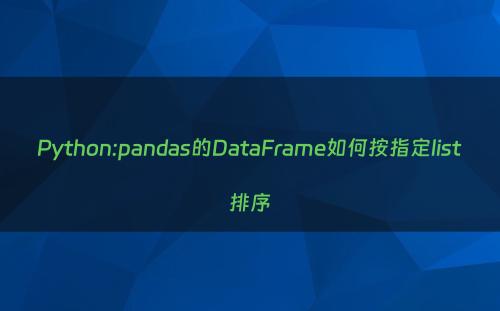网站首页 > 基础教程 正文
现在有一个pandas的Series和一个python的list,想让Series按指定的list进行排序,如何实现?
根据指定的list所包含元素比Dataframe中需要排序的列的元素的多或少,可以分为三种情况:

- 相等的情况下,可以使用 reorder_categories和 set_categories方法;
- list的元素比较多的情况下, 可以使用set_categories方法;
- list的元素比较少的情况下, 也可以使用set_categories方法,但list中没有的元素会在DataFrame中以NaN表示
- 引入pandas库
import pandas as pd
- 构造Series数据
s = pd.Series({'a':1,'b':2,'c':3})
s
a 1
b 2
c 3
dtype: int64s.index
Index(['a', 'b', 'c'], dtype='object')
- 指定的list,后续按指定list的元素顺序进行排序
list_custom = ['b', 'a', 'c']
list_custom
['b', 'a', 'c']- 将Series转换成DataFrame
df = pd.DataFrame(s)
df = df.reset_index()
df.columns = ['words', 'number']
df
设置成“category”数据类型
# 设置成“category”数据类型
df['words'] = df['words'].astype('category')# inplace = True,使 recorder_categories生效
df['words'].cat.reorder_categories(list_custom, inplace=True)
# inplace = True,使 df生效
df.sort_values('words', inplace=True)
df
作者:leenard
链接:https://www.jianshu.com/p/2d3dd3e30d51
来源:简书
著作权归作者所有。商业转载请联系作者获得授权,非商业转载请注明出处。
指定list元素多的情况:
若指定的list所包含元素比Dataframe中需要排序的列的元素多,怎么办?
- reorder_catgories()方法不能继续使用,因为该方法使用时要求新的categories和dataframe中的categories的元素个数和内容必须一致,只是顺序不同。
- 这种情况下,可以使用 set_categories()方法来实现。新的list可以比dataframe中元素多。
list_custom_new = ['d', 'c', 'b','a','e']
dict_new = {'e':1, 'b':2, 'c':3}
df_new = pd.DataFrame(list(dict_new.items()), columns=['words', 'value'])
print(list_custom_new)
df_new.sort_values('words', inplace=True)
df_new
['d', 'c', 'b', 'a', 'e']df_new['words'] = df_new['words'].astype('category')
# inplace = True,使 set_categories生效
df_new['words'].cat.set_categories(list_custom_new, inplace=True)
df_new.sort_values('words', ascending=True)指定list元素少的情况:
若指定的list所包含元素比Dataframe中需要排序的列的元素少,怎么办?
- 这种情况下,set_categories()方法还是可以使用的,只是没有的元素会以NaN表示
注意下面的list中没有元素“b”
list_custom_new = ['d', 'c','a','e']
dict_new = {'e':1, 'b':2, 'c':3}
df_new = pd.DataFrame(list(dict_new.items()), columns=['words', 'value'])
print(list_custom_new)
df_new.sort_values('words', inplace=True)
df_new
['d', 'c', 'a', 'e']df_new['words'] = df_new['words'].astype('category')
# inplace = True,使 set_categories生效
df_new['words'].cat.set_categories(list_custom_new, inplace=True)
df_new.sort_values('words', ascending=True)
作者:leenard
链接:https://www.jianshu.com/p/2d3dd3e30d51
来源:简书
著作权归作者所有。商业转载请联系作者获得授权,非商业转载请注明出处。
猜你喜欢
- 2025-01-06 Python数据结构与算法(13)——选择排序
- 2025-01-06 用Python实现列表排序,给定列表并进行升序降序排序(第一节)
- 2025-01-06 Python版的迷你程序——快速排序
- 2025-01-06 10个小技巧,让你的 Python 代码更加优雅
- 2025-01-06 算法浅谈——分治算法与归并、快速排序(附代码和动图演示)
- 2025-01-06 使用 Python 的sorted()函数对复杂可迭代对象进行排序
- 2025-01-06 一行Python代码:10个利用sort()函数解决复杂问题的案例
- 05-22Linux cron任务计划
- 05-22测试人员如何在linux服务器中查询mysql日志?
- 05-22Nginx命令最全详解(29个最常用命令)
- 05-22初识自动化网络编排器NSO,轻松配置复杂的多厂商网络
- 05-22Nacos在企业生产中如何使用集群环境?
- 05-22如何从 MySQL 错误日志中排查数据库故障
- 05-22Linux面试最高频的5个基本问题
- 05-22linux网卡混杂模式
- 最近发表
- 标签列表
-
- jsp (69)
- gitpush (78)
- gitreset (66)
- python字典 (67)
- dockercp (63)
- gitclone命令 (63)
- dockersave (62)
- linux命令大全 (65)
- pythonif (86)
- location.href (69)
- dockerexec (65)
- tail-f (79)
- deletesql (62)
- c++模板 (62)
- linuxgzip (68)
- 字符串连接 (73)
- nginx配置文件详解 (61)
- html标签 (69)
- c++初始化列表 (64)
- mysqlinnodbmyisam区别 (63)
- arraylistadd (66)
- console.table (62)
- mysqldatesub函数 (63)
- window10java环境变量设置 (66)
- c++虚函数和纯虚函数的区别 (66)
